Pilates has a lot of benefits for our health which also includes Strength Training however, Pilates can indeed count as strength training, though its approach and benefits can differ from traditional strength training methods. Let’s get into the depth of how doing pilates counts as strength training.
Table of Contents
ToggleWhat is Pilates?
Pilates is a physical fitness system that was developed by Joseph Pilates in the early 20th century. However, it improves core strength, flexibility, balance, and overall body alignment. Pilates exercises can be performed on a mat or using specialized equipment such as the Reformer, Cadillac, and Wunda Chair.
Core Principles of Pilates
The core principles of Pilates are:
- Core Strength: Pilates emphasizes the importance of a strong core, that includes the muscles of the abdomen, lower back, hips, and pelvis.
- Controlled Movements: The exercises are performed with precise control, that aims for proper form and alignment.
- Breathing: Proper breathing techniques are integral to Pilates, helping to engage the core muscles and improve overall performance.
- Flexibility and Balance: Pilates focuses on enhancing flexibility and balance, which contribute to a well-rounded fitness regimen.
Pilates and Strength Training
Strength training especially involves exercises that are designed to improve strength and endurance by exerting resistance against the muscles. This resistance comes from various sources, including free weights, resistance bands, machines, or even body weight. The primary goal is to challenge the muscles, leading to increased muscle mass, improved strength, and better overall physical performance.
1. Muscle Engagement
In traditional strength training, resistance is used to target specific muscle groups, which leads to muscle hypertrophy (growth). Pilates, while not always using external weights, engages muscles through body resistance and controlled movements. Exercises like the Pilates push-up or the hundred involve substantial muscle engagement, particularly in the core.
Pilates Exercises for Strength:
- The Plank: Targets the core, shoulders, and arms, similar to traditional core-strengthening exercises.
- Leg Circles: Strengthens the hip flexors and core while improving flexibility.
- Pilates Push-ups: Focuses on the chest, arms, and core, providing a different challenge compared to traditional push-ups.
2. Resistance Training
Pilates equipment, like the Reformer, uses springs and pulleys to provide resistance, making the exercises comparable to using weights in traditional strength training. The adjustable resistance levels on a Reformer can be tailored to suit various strength levels and training goals.
Key Pilates Equipment for Strength Training:
- Reformer: Offers adjustable resistance through springs, providing a range of exercises that enhance strength and flexibility.
- Cadillac: Uses a variety of spring attachments to challenge different muscle groups, similar to weight machines.
- Wunda Chair: Provides resistance training through its compact design, targeting core strength and stability.
3. Muscle Endurance
While traditional strength training often focuses on building muscle mass, Pilates enhances muscle endurance. The exercises are performed in a controlled manner and often involve holding positions or repeating movements, which builds stamina and muscle endurance over time.
Endurance-Building Pilates Exercises:
- Side Planks: Improve core endurance and stability.
- Pilates Roll-Up: Enhances abdominal endurance and flexibility.
- Teaser: A challenging move that builds core strength and endurance.
4. Functional Strength
Pilates emphasizes functional movements that improve overall body mechanics and strength. The exercises often mimic everyday activities, which helps in developing functional strength that translates to daily life. This type of strength training is less about isolated muscle building and more about overall body integration and efficiency.
Functional Pilates Exercises:
- Single-Leg Stretch: Enhances core stability and coordination.
- Swan Dive: Improves back strength and flexibility, contributing to better posture.
5. Core Stability
Core stability is a cornerstone of Pilates. A strong and stable core supports the entire body, improves posture, and reduces the risk of injury. This aspect of Pilates aligns with strength training’s goal of building a strong foundation for overall strength and physical performance.
Core Stability Pilates Exercises:
- The Hundred: Strengthens the core and improves endurance.
- Criss-Cross: Targets the obliques and enhances rotational strength.
- Double Leg Stretch: Builds core stability and coordination.
Benefits of Pilates with Strength Training
1. Improved Core Strength
Benefit: Pilates places a strong emphasis on core strength, which includes the muscles of the abdomen, lower back, hips, and pelvis. A strong core is fundamental for overall strength and stability.
How It Helps:
- Support for Other Exercises: A well-developed core supports the spine and improves posture, which can enhance performance and reduce the risk of injury during traditional strength training exercises.
- Injury Prevention: A strong core helps stabilize the body during dynamic movements, reducing strain on the lower back and other vulnerable areas.
2. Enhanced Muscle Endurance
Benefit: Pilates exercises often involve holding positions and performing controlled movements over extended periods, which builds muscular endurance.
How It Helps:
- Increased Stamina: Improved muscle endurance from Pilates allows you to sustain longer and more intense strength training sessions.
- Better Recovery: Enhanced endurance can lead to quicker recovery between sets and workouts.
3. Improved Flexibility and Range of Motion
Benefit: Flexibility is a key component of Pilates, that helps in increasing the range of motion of joints and muscles.
How It Helps:
- Greater Movement Efficiency: Improved flexibility can enhance your performance in strength training by allowing for a full range of motion in exercises.
- Reduced Injury Risk: Greater flexibility helps prevent injuries related to muscle strain or joint stiffness during strength exercises.
4. Balanced Muscle Development
Benefit: Pilates focuses on balanced muscle development and functional strength, rather than isolating people’s muscles.
How It Helps:
- Symmetrical Strength: Balanced muscle development reduces the risk of overuse injuries and imbalances that can arise from traditional strength training.
- Functional Fitness: Functional strength gained from Pilates translates to better performance in daily activities and other sports or fitness routines.
5. Enhanced Body Awareness and Control
Benefit: Pilates encourages mindfulness of body mechanics and control over movements, which improves proprioception (awareness of body position).
How It Helps:
- Better Technique: Improved body awareness helps in performing strength training exercises with proper form, reducing the risk of injury and enhancing effectiveness.
- Coordination: Increased control and coordination contribute to smoother execution of complex strength training movements.
6. Core Stability and Balance
Benefit: Pilates exercises often focus on core stability and balance, which are crucial for overall strength and functional movement.
How It Helps:
- Stable Base: A stable core provides a solid foundation for other exercises, allowing for more effective and safer strength training.
- Improved Balance: Enhancing balance from Pilates helps perform strength exercises that require stability, such as single-leg exercises or balance-based movements.
7. Injury Rehabilitation and Prevention
Benefit: Pilates is often used in rehabilitation settings due to its low-impact nature and focus on strengthening and stabilizing muscles.
How It Helps:
- Rehabilitation: Pilates exercises can be tailored to rehabilitate specific injuries by focusing on gentle strength-building and improving movement patterns.
- Prevention: Strengthening the muscles around vulnerable joints helps prevent injuries and supports better overall alignment and posture.
8. Efficient Use of Body Weight
Benefit: Many Pilates exercises use body weight for resistance, which helps build strength without the need for external equipment.
How It Helps:
- Accessibility: Pilates can be performed anywhere, making it a convenient option for complementing strength training without requiring additional equipment.
- Functional Strength: Body weight exercises often mimic natural movements, enhancing functional strength that supports everyday activities.
9. Mind-Body Connection
Benefit: Pilates emphasizes the connection between mind and body through focused breathing and controlled movements.
How It Helps:
- Mental Focus: Enhanced mental focus and awareness during Pilates can translate to better concentration and technique in strength training exercises.
- Stress Reduction: The mindfulness aspect of Pilates helps reduce stress, which can improve overall fitness performance and recovery.
10. Postural Alignment
Benefit: Pilates promotes proper alignment and posture through targeted exercises that address muscle imbalances and promote optimal body mechanics.
How It Helps:
- Enhanced Posture: Improved posture from Pilates supports better form in strength training exercises and reduces the risk of postural-related injuries.
- Reduced Strain: Proper alignment reduces unnecessary strain on muscles and joints during strength training, contributing to overall effectiveness and safety.
Pilates for Strength Training
1. The Plank
Target Muscles: Core, shoulders, and arms.
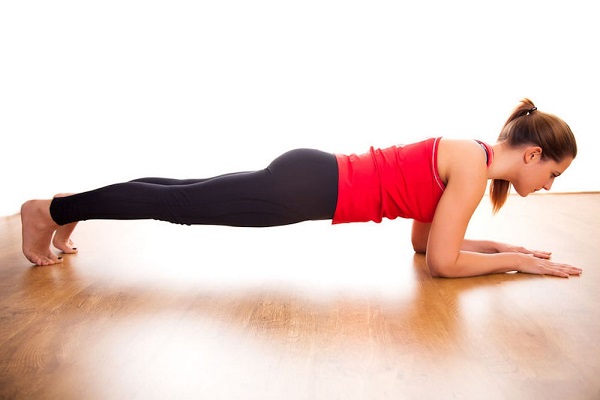
How to Do It:
- Start in a push-up position with your hands directly under your shoulders and your body in a straight line from head to heels.
- Engage your core and hold the position, keeping your hips stable and avoiding any sagging or lifting.
- Hold for 30 seconds to 1 minute, gradually increasing the duration as you build strength.
2. The Hundred
Target Muscles: Core, especially the abdominal muscles.
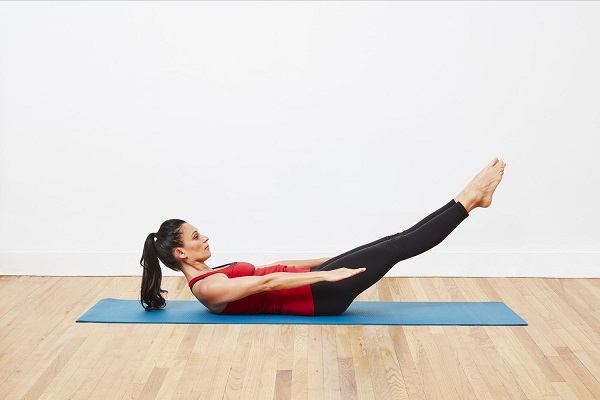
How to Do It:
- Lie on your back with your legs lifted to a 90-degree angle and your arms extended by your sides.
- Curl your head, neck, and shoulders off the mat while pumping your arms up and down in small, controlled motions.
- Inhale for 5 pumps and exhale for 5 pumps, completing a total of 100 pumps.
3. Single-Leg Stretch
Target Muscles: Core, hip flexors, and thighs.
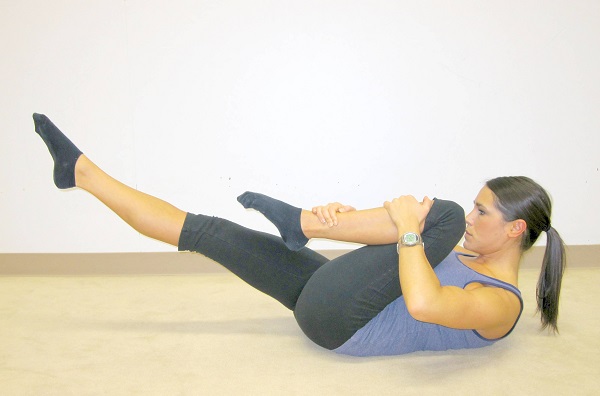
How to Do It:
- Lie on your back with your legs extended and your head, neck, and shoulders lifted.
- Bring one knee toward your chest while extending the other leg straight out.
- Hold your knee with both hands and switch legs in a controlled manner, maintaining a stable core.
4. The Roll-Up
Target Muscles: Core, especially the abdominals.
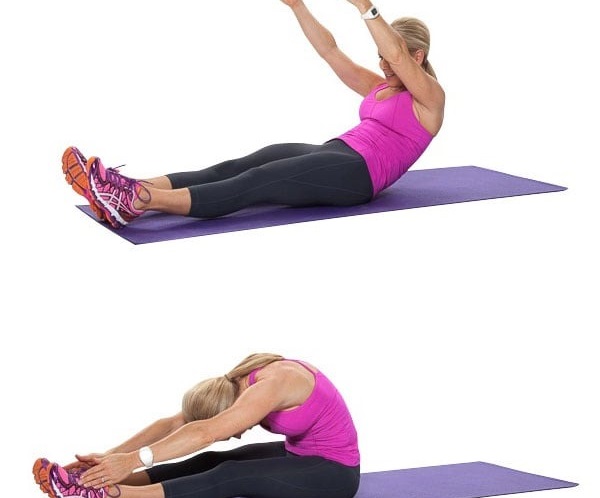
How to Do It:
- Lie on your back with your legs extended and your arms reaching overhead.
- Inhale and engage your core as you slowly roll up, reaching for your toes.
- Exhale as you roll back down to the starting position, one vertebra at a time.
5. Teaser
Target Muscles: Core, hip flexors, and thighs.

How to Do It:
- Lie on your back with your knees bent and feet flat on the mat.
- Lift your head, shoulders, and legs off the mat while reaching your arms forward and balancing on your tailbone.
- Hold the position briefly before lowering back down with control.
6. Side Plank
Target Muscles: Core, especially the obliques, and shoulders.
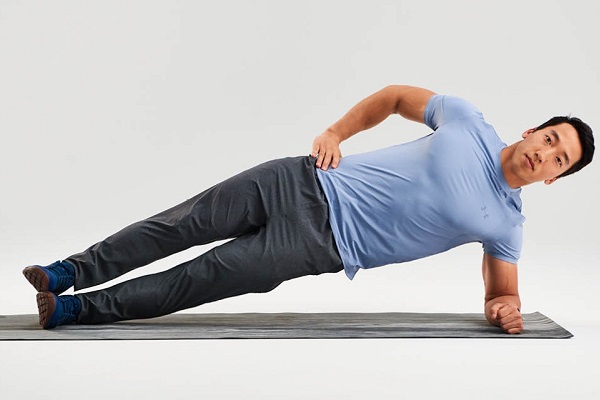
Experience Life Magazine – LifeTime.Life
How to Do It:
- Start in a side-lying position with your elbow directly under your shoulder and your legs stacked.
- Lift your hips off the mat, creating a straight line from head to heels.
- Hold the position for 30 seconds to 1 minute, then switch sides.
7. Pilates Push-Up
Target Muscles: Core, chest, shoulders, and arms.
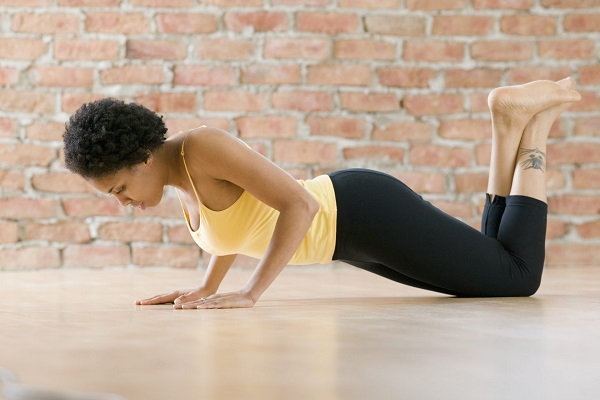
How to Do It:
- Start in a push-up position with your hands slightly wider than shoulder-width apart.
- Lower your body towards the mat, keeping your elbows close to your sides.
- Push back up to the starting position with control.
8. Leg Circles
Target Muscles: Core, hip flexors, and inner thighs.
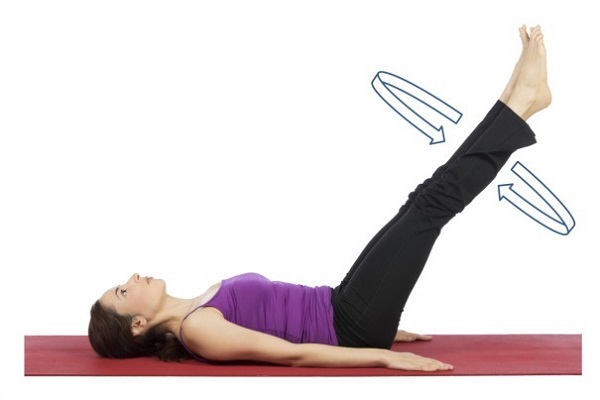
How to Do It:
- Lie on your back with one leg extended towards the ceiling and the other leg flat on the mat.
- Make small circles with the extended leg, keeping your hips stable and core engaged.
- Perform circles in both directions before switching legs.
9. Double Leg Stretch
Target Muscles: Core, hip flexors, and thighs.
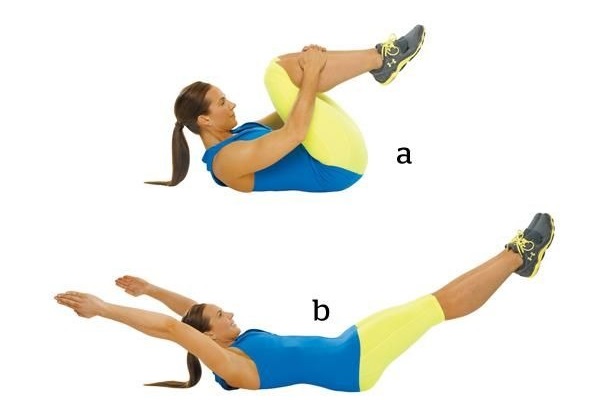
How to Do It:
- Lie on your back with your knees bent and feet lifted off the mat.
- Extend your legs out and your arms overhead as you inhale, then bring them back to the starting position as you exhale.
10. Swan Dive
Target Muscles: Back, core, and glutes.
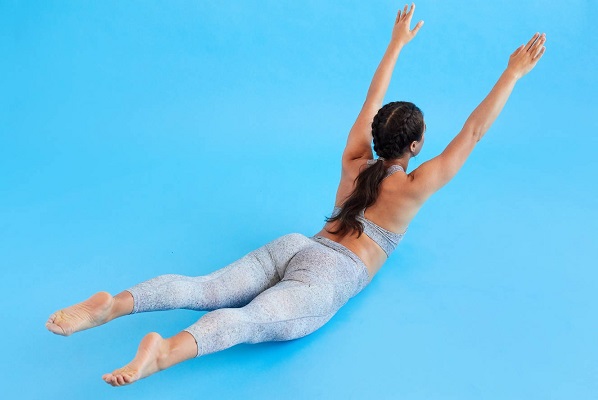
How to Do It:
- Lie on your stomach with your hands under your shoulders and your legs extended.
- Lift your chest and head off the mat, extending your back.
- From this position, lift your legs and arch your back, then gently lower back down with control.
Adopt Pilates into Your Strength Training Routine
- Warm-Up: Start with a few minutes of Pilates exercises to activate your core and prepare your body for strength training.
- Strength Training: Incorporate traditional strength training exercises with weights or resistance bands to target specific muscle groups.
- Cool-Down: Use Pilates exercises to cool down and stretch, improving flexibility and aiding recovery.
- Regular Practice: Incorporate these Pilates exercises regularly into your routine to build and maintain strength, flexibility, and overall fitness.
Who should not try doing Pilates?
As we all know Pilates offers a lot of benefits however there are some people who should not try doing Pilates,
1. Individuals with Severe Osteoporosis
Pilates involves a range of movements that can put stress on the bones, especially in exercises involving spinal flexion or extension.
Recommendation: Individuals with severe osteoporosis should consult with their healthcare provider before starting Pilates. If approved, they should work with a certified Pilates instructor who is experienced in modifying exercises for osteoporosis.
2. People with Acute or Uncontrolled Medical Conditions
People with acute or uncontrolled medical conditions, such as severe cardiovascular issues or uncontrolled diabetes, may face risks with physical activity.
Recommendation: Those with such conditions should seek medical clearance before engaging in any form of exercise, including Pilates. A healthcare professional can provide personalized advice on safe exercise options.
3. Individuals with Recent Surgery or Injury
Recent surgery or injury can impact one’s ability to safely perform Pilates exercises, especially if the area affected is still healing.
Recommendation: It’s important to get medical clearance and possibly work with a physical therapist or Pilates instructor who specializes in rehabilitation to ensure exercises are adapted appropriately for recovery.
4. Pregnant Women with Complications
While Pilates can be beneficial during pregnancy, certain modifications are necessary to accommodate the changes in the body and to avoid exercises that might strain the abdominal muscles or affect the pelvic floor.
Recommendation: Pregnant women should consult with their healthcare provider and work with a Pilates instructor who is experienced in pre-natal Pilates to ensure exercises are safe and appropriate.
5. Individuals with Specific Musculoskeletal Issues
Conditions such as severe herniated discs, advanced scoliosis, or severe joint instability may require specific adjustments to Pilates exercises.
Recommendation: Those with significant musculoskeletal issues should consult with a healthcare provider and work with a Pilates instructor who is knowledgeable in adapting exercises for these conditions.
6. People with Severe Balance or Coordination Issues
Pilates exercises often require balance and coordination, which can be challenging for individuals with severe balance issues or neurological conditions.
Recommendation: Individuals with significant balance or coordination problems should consult with their healthcare provider. Modified or alternative exercises may be recommended to accommodate their needs.
7. Those with High Blood Pressure
Some Pilates exercises, particularly those involving inversion or straining movements, might affect blood pressure.
Recommendation: Individuals with high blood pressure should consult with a healthcare provider before starting Pilates. They may need to avoid certain positions or exercises and focus on those that are safe for their condition.
8. Individuals with a History of Severe Eating Disorders
Intense focus on body image or weight can sometimes be exacerbated by any form of exercise, including Pilates.
Recommendation: Those with a history of severe eating disorders should approach Pilates with caution and ideally work with a mental health professional to ensure that their exercise routine supports their overall well-being.
9. People with Severe Rheumatoid Arthritis
Rheumatoid arthritis can cause joint pain and inflammation, making certain Pilates exercises uncomfortable or contraindicated.
Recommendation: Consult with a healthcare provider to tailor Pilates exercises to accommodate joint pain and inflammation. Gentle, modified exercises can often be beneficial.
10. Individuals New to Exercise or with Low Fitness Levels
While Pilates is generally accessible, beginners or those with very low fitness levels might find some exercises challenging.
Recommendation: Beginners should start with foundational Pilates exercises and possibly work with a certified instructor to gradually build strength and flexibility.
Conclusion
In summary, Pilates can indeed count as a form of strength training, particularly in terms of core strength, muscle endurance, and functional strength. While it may not always provide the same level of resistance as traditional strength training methods, Pilates offers unique benefits that enhance overall physical performance and well-being.
By integrating Pilates with traditional strength training, you can achieve a balanced and comprehensive fitness routine that supports strength, flexibility, and overall health. Whether you’re a beginner or an experienced athlete, combining these approaches can help you achieve your fitness goals and maintain a well-rounded and effective workout regimen.
FAQs
Is Pilates a good workout for strength training?
Yes, Pilates can be effective for building strength, particularly in the core, and it can complement traditional strength training by improving stability and flexibility.
Can beginners do Pilates?
Yes! Pilates can be adapted for all fitness levels, and beginners can start with basic exercises and gradually progress.
How often should I do Pilates?
For optimal benefits, practising Pilates 2-3 times a week is recommended, though even occasional practice can be beneficial.
Also, read more about 20 Exercises Postures that Improves your body and reliefs Pain
